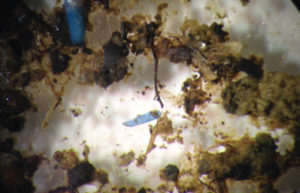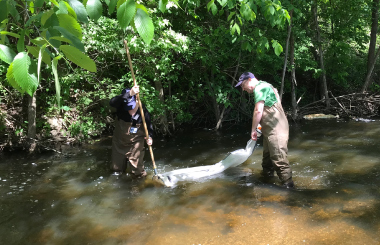The Problem: It’s Bigger than an Ocean
When most people think of plastic pollution, they think of huge floating islands of plastic waste in oceans. And they are correct. The oceans host vast amounts of plastic waste that breaks down in water and harms aquatic life. It also breaks down in our rivers and lakes, polluting our home waters far from any ocean, including the Huron River. Some of it is big enough to see and the rest are pieces so small, you need a microscope to see them.
Microplastics in the Great Lakes and the Huron River

Microplastics are tiny pieces of plastic (less than 5 millimeters/0.2 inches) and are mostly invisible to the naked eye. They slough off of articles of clothing when they are being washed and fall off of decomposing plastic bottles, bags, and other debris.
Scientists have found microplastics nearly everywhere, including oceans, lakes, rivers, and aquatic animals. Fibers, which contribute the most to our local microplastics pollution, are washed into our streams and rivers after synthetic clothes and textiles, such as fleece and athletic gear, are laundered. These fibers are so tiny, they are not filtered out during the water treatment process.
Where Does it Come From?
The USGS studied microplastics in 29 Great Lakes tributaries and found that the highest levels of microplastics are in the Huron River. The study identified sources for the Great Lakes tributaries:
| Type of microplastic pollution | Percentage of the total number of microplastics particles found in samples of 29 Great Lakes river water | Source of microplastic |
|---|---|---|
| Fibers | 70% | synthetic textiles, diapers, cigarettes |
| Fragments | 16.7% | water bottles |
| Foams | 7.6% | styrofoam |
| Films | 3.3% | bags and wrappers |
| Beads | 1.67% |
Impacts
Microplastics can be harmful to humans, as well as wildlife through:
- The physical hazards of ingesting plastic particles (fish, birds, and other animals can experience digestive obstruction, impaired reproduction, other adverse biological effects, and even death)
- The unhealthy additives found in plastic particles (some additives have been associated with cancer and endocrine disruption)
- The contaminants that accumulate on plastic particles (polychlorinated biphenyls (PCB’s), polycyclic aromatic hydrocarbons (PAH’s), organochlorine pesticides, trace metals, and even pathogens have been found at high concentrations on microplastics.
(source: USGS)
Research on the human health impacts of ingesting microplastics is in its infancy. More data is needed on how the different types of plastics we consume affect us and the impacts of how we ingest them such as eating contaminated fish, drinking liquids, and breathing in dust. Here is a report from a 2017 Microplastics Expert Workshop convened by the US EPA that discusses existing and needed research.
There is good news
Now that we know synthetic microfibers, such as polyester and nylon, are largest sources of microplastics in the Huron River, we can be strategic about where to focus our local efforts.
TOP 5 things you can do to reduce pollution from microfibers
- Get a filter for your washing machine (330 microns or less, like the Fitrol, Lint Luv, or Girlfriend Collective’s Microfiber Filter ) so it captures microplastics before the waste water enters the waste water treatment (or septic) system.
- Use laundry devices that capture fibers during the wash cycle such as GuppyFriend Bags or Cora Balls*
- If you’re in the market for a new washing machine, get a front load machine instead a top loader (fibers shed less in front load machines.) Ask washing machine companies to include filters with their products, like the Xeros system.
- Wear clothes made with natural fibers or look for synthetic/cotton blends, which shed less, and try to wash your synthetics less frequently.
- Contact your favorite large clothing manufacturer (those that use synthetic fibers, like athletic clothing) and ask them what they are doing about microplastic pollution from their synthetic fiber products.
*HRWC has no more Cora Balls in stock. Please get them directly from Cora Ball.
Ban all Plastic? Not so Fast. It’s complicated.
Plastic pollution is a worldwide issue that requires global changes. The issue is complicated. Plastics replace materials we would otherwise need to extract from natural resources. And it doesn’t take as much energy to produce some plastics so there are fewer carbon emissions in the production cycle. (Since carbon emissions contribute to climate change, the fewer the better.) Plastics enable us to preserve food for longer so there is less waste. Below is a 9-minute video that does a great job explaining the complexities.
Here’s What Else You Can Do
- To address local microplastic pollution, the best actions to take are the Top 5 actions listed above to #CatchthePlastic from synthetic textiles like athletic clothing and fleece.
- Share the word! Tell people about the issue and what you’ve learned. You can share our videos on your feeds for a quick, click-n-post option. Use #hrwc and #CatchThePlastic hashtags.
- Scoop it up. Gather friends and do a river or beach clean-up. Every bit counts. Plus it’s a free activity that provides lots of fresh air. Post photos of your good deeds to inspire others. (Don’t forget those hashtags!)
- Contact large clothing manufacturers and ask them if they are doing research on which synthetic textiles shed the most and if they are looking for solutions. Start with those that make athletic and fleece clothes.
- Let politicians know this is an issue you care about. Ask them what they are doing about it. Let them know you want them to fund research on impacts and sources. Ask them to support polices such as banning forms of single use plastic (bags, straws, and product packaging). And ask them to form international partnerships to address the issue on a global scale.





